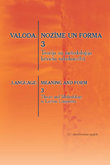Partikulas gramatizēšanās aspektā
Particles in the aspect of grammaticalization
Author(s): Evelīna ZilgalveSubject(s): Language and Literature Studies, Theoretical Linguistics, Semantics, Baltic Languages
Published by: Latvijas Universitātes Akadēmiskais apgāds
Keywords: partikulas; apstākļa vārdi; desemantizēšanās; slēptais saturs; konvencionālā implikatūra; homonīmija;
Summary/Abstract: There is the desemanticization and transition into particles of the words maz, tad, vēl and vispār analyzed in this article. Since the functions of adverbs and particles in the sentence are similar, there are two criteria set for separation of adverbs and particles: locality of the word in the sentence and the implicit content.Locality in the utterance is an important criteria in the aspect of grammaticalization: an adverb next to another adverb loses its meaning becoming a particle – it is desemanticized. For example, in the utterances Viņi runās tad, kad būs tam gatavi (..). ‘They will speak (then), when they are ready for that (..)’; Kad Buda vēl nebija Buda ‘When Buda was not Buda yet’ the words tad and vēl next to the adverb kad are desemanticized.It is considered that particles utter conventional implicatures – implicit content that is uttered by the meaning of one word. The words maz, tad and vispār in interrogative sentences show the relation with a prior speaker’s assumption, e. g. Vai tad Kanāda nav zem Amerikas? ‘The Canada is under the America, isn’t it?’ shows the assumption: The Canada is under the America. The words maz and vispār can be switched in interrogative sentences, without changing its meaning, e. g. Vai maz/vispār iespējams nomest lieko svaru? ‘Is it possible to lose weight at all?’ have the same assumption lieko svaru nomest nav iespējams ‘it is not possible to lose weight’. The word vispār should be considered as an adverb which has been desemanticized in interrogative questions.There is not one common opinion on the meaning of the word vēl and which part of the words it belongs to. A point of reference and the added information both are important in the meaning of vēl. For example, the utterance Ā, mēs vēl tik tālu neesam tikuši (..). ‘Oh, we are not that far yet (..)’ shows an addition in time – the action is happening during the speech moment but one has not reached the particular point of action that the speaker is talking about. Whereas the utterance Man, lūdzu, vēl vienu kafiju! ‘One more coffee for me, please!’ shows the addition in space. There has been at least one coffee requested before this request.
Journal: Valoda: nozīme un forma
- Issue Year: 2013
- Issue No: 3
- Page Range: 142-158
- Page Count: 17
- Language: Latvian

